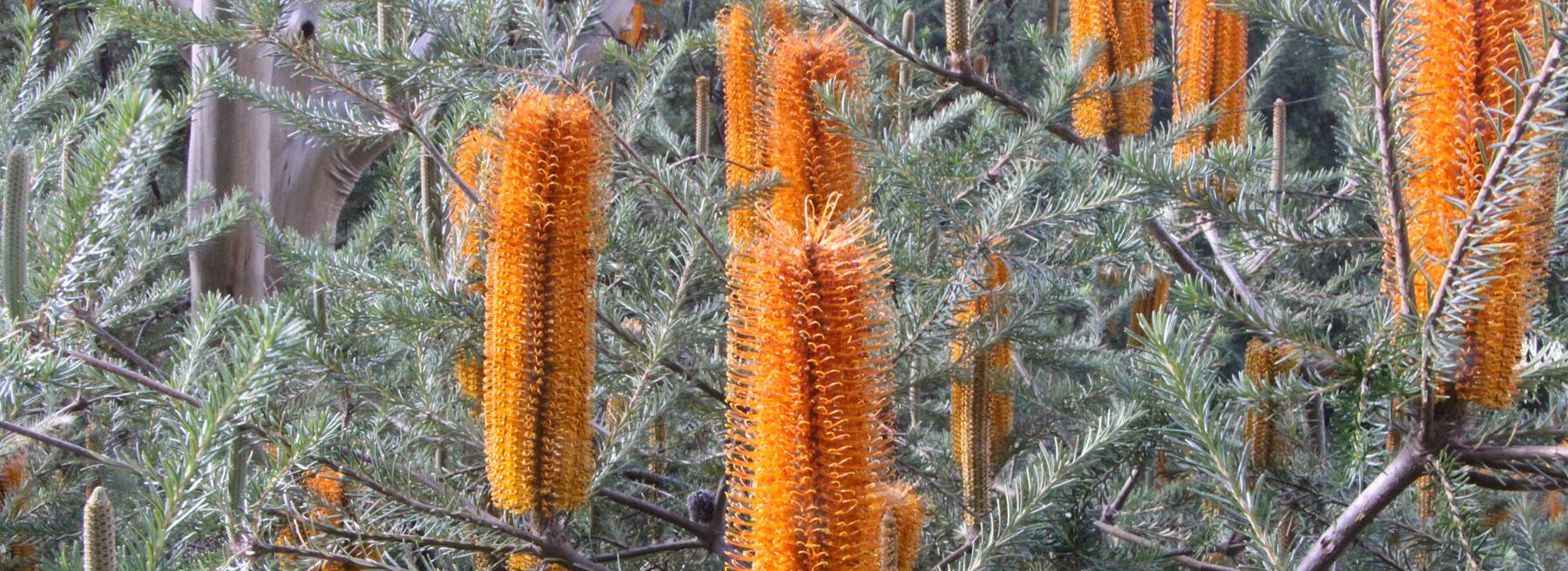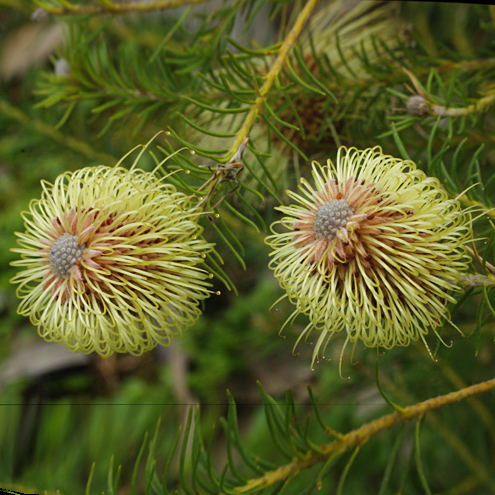Banksia – Background
Introduction
Banksia is a genus of over 200 species in the Protea family (Proteaceae). All species occur in Australia with one (B.dentata) extending to islands to Australia’s north. Banksias can be found in most environments; the tropics, sub-alpine areas, the coast and desert areas. The most diversity in the genus occurs in the south of Western Australia where most of the species occur.
Until recently, the genus comprised 78 species, most with the familiar candle-like shaped flower clusters. However, a paper published in February 2007 (see below) proposed that the genus Dryandra be subsumed into Banksia. The paper published new names in Banksia for all (then) currently recognised Dryandra species. This revised classification has been accepted by the Council of Heads of Australasian Herbaria and the new names now appear on Florabase (the website for the Western Australian Herbarium) and in the Australian Plant Census, which is the main online reference for names of Australian native plants.
Mast A R and Thiele K; The transfer of Dryandra R.Br. to Banksia L.f. (Proteaceae); Australian Systematic Botany, 26 February 2007
This reclassification increased the number of Banksia species significantly but the revised classification has not met with universal approval. For example, Alex George, a highly respected authority on both Banksia and Dryandra, strongly opposes the change on scientific grounds. The two opposing views are set out in the following articles:
- You don’t have to call Dryandra Banksia” by Alex George.
- Why dryandras have changed their name by Kevin Thiele.
As ANPSA recognises the Australian Plant Census as the authority on plant names, the revised classification has now been adopted on the ANPSA website. However, recognising that the reclassification is controversial, the former Dryandra names are listed alongside the corresponding Banksia names, where appropriate. Regardless of this scientific re-classification, species previously classified under Dryandra remain quite distinctive horticulturally and will undoubtedly still be called dryandras in common usage.
Characteristics of Banksia
Banksia flowers are quite small but they occur in dense clusters which, in some species, can number several thousand individuals. The sequence of opening of each flower goes through several stages:

- In bud, each flower appears as an elongated narrow tube (the perianth) comprising four segments each having an anther containing pollen at its tip.
- As the flower opens, the perianth segments separate to reveal a narrow style. Just before the flower fully opens the anthers transfer their pollen to the tip of the style (the stigma)
- Finally, the style separates from the perianth. At this stage the style and stigma, with attached pollen, is called a ‘pollen presenter’ (i.e. it is ‘presenting’ the pollen to a pollinator, usually a bird or small marsupial, which acts as the agent to transfer pollen from one flower to another for fertilisation.
This sequence is shown in the accompanying diagram and is fairly typical of most members of the Proteaceae.
In general terms the genus Banksia can be broadly characterised into three groups, based on the arrangement of the flower clusters:
- Flowers arranged around a vertical axis, giving the familiar cylindrical inflorescence (previously classified as Banksia subgenus Banksia).
- Flowers are arranged in cone-shaped clusters without bracts (previously classified as Banksia subgenus Isostylis).
- Flowers are arranged in cone-shaped clusters surrounded by overlapping, scale-like bracts which often form a conspicuous part of the inflorescence (previously classified as genus Dryandra).
This grouping is illustrated below.

Family Relationships
Left: Banksia menziesii, a ‘typical’ Banksia with flowers arranged around a vertical axis.
Centre: Banksia cuneata, with cone-shaped flower clusters.
Right: Banksia heliantha (syn. Dryandra quercifolia), with cone-shaped flower clusters surrounded by bracts.
Photos: Jim Barrow, Brian Walters
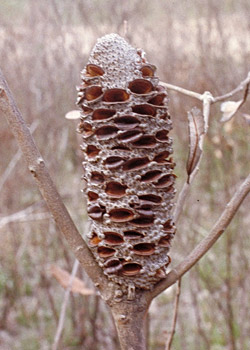
Photo: Brian Walters
The flowers are followed by more or less woody follicles each containing one or two seeds. In ‘typical’ banksias, the seeds occur in woody seed “cones” in which the seeds are contained within closed follicles, two seeds per follicle. In the former genus Dryandra, the follicles are hidden within the spent flower clusters. In both cases, these follicles usually remain tightly closed unless stimulated to open by heat, such as following a bushfire but, with a few species, the seed is released annually. The seeds themselves have papery wings which allows them to be distributed by wind.The flower clusters of most Banksia species are cream, yellow, brown or orange in colour. There are a few species where the inflorescence can have a pink colour in certain forms (eg. B.praemorsa, B.fraseri, B.undata).
Most banksias are small to medium shrubs but there are many which are prostrate with underground stems and a few can become large trees. Those species native to areas where fires occur at regular intervals often have a “lignotuber”, a woody swelling at or below ground level from which regeneration of the plant can occur if the above ground stems are destroyed. Other species are killed in fire, with seedlings sprouting in their place.
Discovery
Archaeological evidence suggests that banksias or Banksia-like plants have existed for over 40 million years. The first humans to discover and make use of Banksia plants were the Australian aborigines who used the nectar from the flowers as part of their diet.
The first Europeans to observe banksias were probably Dutch explorers who made several landfalls along the West Australian coast during the 17th and early 18th centuries. No botanical collections were made, however, until the discovery of the east coast of Australia by Captain James Cook in the Endeavour in April 1770. Accompanying Cook were botanists Joseph Banks and Daniel Solander who collected many new species at Botany Bay including four which would later be included in a new genus, Banksia, named in honour of Joseph Banks’ contribution to botany. The four species collected were B.serrata, B.ericifolia, B.integrifolia and B.robur. Later, on the same voyage, Banks and Solander collected a fifth species (B.dentata) on the north Queensland coast.
New banksias are still being discovered from time to time. Recent discoveries include:
- Banksia rosserae – Near Mt Magnet, Western Australia (2002)
- Banksia croajingolensis – East Gippsland, Victoria (2007)
- Banksia vincentia – Jervis Bay, New South Wales (2014)
Banksia – Propagation
Introduction
Most banksias are propagated by seed but it is becoming more common to use vegetative propagation (eg. cuttings) to enable desirable forms and flower colours to be maintained.
Seed
Seed Removal from Follicles
- Species with woody seed cones: With those species where seed is retained on the mature cones, extracting the seeds usually requires heat (eg in an oven for about 1 hour at 125 degrees C). This forces the follicles to open and the seed can often be shaken out. Sometimes, however, the follicles do not open sufficiently and some additional treatment may be needed to release the seed. One method that has been successful with some species is to plunge the seed cones into cold water immediately after heating and allow them to soak for about a day. After soaking, the cones are allowed to dry in a warm, dry position where the follicles should open sufficiently to allow the seed to be shaken out or to be carefully eased out with a knife. This process can be repeated many times for those species which prove reluctant to release their seeds.
- Species in which follicles are hidden within the spent flower clusters (the ‘dryandra’ group): With those species with woody follicles, extracting the seeds usually requires heat (eg in an oven for about 20 minutes at about 150 degrees C). This forces the follicles to open and the seed can often be shaken out. Sometimes, however, the follicles do not open sufficiently and it may be necessary to repeat the heat treatment. With species having softer follicles, the seed may be removed by cutting the follicles along the top with strong scissors, thereby enabling the two sides to be prised open.
Seed Germination
Seed usually germinates well by conventional sowing methods in seed raising mixes although seedlings may be subject to “damping off”. To minimize this possibility, keep seeds moist but not wet. Germination should occur in 14 to 60 days, depending on the species. Seeds of those species from semi-alpine areas, such as B.canei and B.saxicola, require “stratification” (exposure to a period of low temperature) to enable germination to take place. One method of stratification is to place the seed on a layer of moist vermiculite or sand in a container in a refrigerator for 1-2 months before sowing.
Pre-germination of seed by sowing into a closed container containing moist vermiculite or a similar material is also a useful method of germinating seeds, particularly for winter sowing when outdoor temperatures may be unsuitable. Germination usually occurs in 1-3 weeks using this method and when the root has reached about a centimetre or so in length, the seedling can be placed into a small pot of seed raising mix.
Cuttings
Banksias which are propagated from seed may show variation in flower colour and growth habit from the original plant. In order to preserve desirable plant characteristics, propagation by cuttings is becoming more common.
Banksias are not the easiest plants to propagate by cuttings, particularly the large-leafed species, but it is certainly not impossible. Cuttings about 75-100 mm in length with the leaves carefully removed from the lower two-thirds seem to be satisfactory. “Wounding” the lower stem by removing a sliver of bark and treating with a “root promoting” hormone both seem to improve the success rate.
Cuttings of some species may be slow to strike (6 months or more).
Grafting
Because of the difficulty of growing many Western Australian species in climates of summer rainfall (see “Cultivation”), a considerable amount of experimentation has been done, mainly by amateur growers, on grafting western species to hardier root stocks. This work has shown some success and a limited range of grafted banksias are now obtainable from specialist growers.
General Propagation
For detailed information on Banksia propagation methods, see the very detailed article The Propagation of Banksia.
Further details on general plant propagation can be found in the Plant Propagation section.
Banksia – Cultivation
Banksias are popular garden plants although the majority of species native to Western Australia are generally difficult to maintain for any length of time in areas of high summer humidity and rainfall (such as the eastern coastal strip of Australia). This is especially true of those species previously included in the genus Dryandra. Some success has been achieved with ‘dryandras’ such as Banksia formosa (syn Dryandra formosa) and Banksia undata (syn. Dryandra praemorsa) in inland New South Wales and Queensland but, generally, ‘dryandras’ are not particularly reliable in coastal areas of those two states. On the other hand, good results have been achieved with a range of species in Victoria and in the south-east of South Australia, particularly in sandy, well drained soils. Generally the genus can be regarded as very suitable for areas with a Mediterranean-style climate with wet winters and fairly dry summers.
With many different forms, growth habits and flower colours, banksias can be used for many different purposes in the garden. In addition, the flowers of all banksias produce nectar and are excellent for attracting birds.
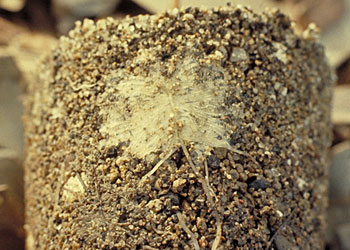 |
| A cluster of proteoid roots Photo: Brian Walters |
Like most members of the Protea family, banksias have a distinctive root system (“proteoid roots”) consisting of tight groupings of many small “rootlets”. These are believed to enable the plants to more efficiently take up nutrients from the nutrient-deficient soils where many of the species occur naturally. In cultivation this means that the plants can be adversely affected by fertilizers, particularly phosphorus. It is generally recommended that banksias and other Proteaceae be fertilised only with low-phosphorus, slow-release fertilisers or not be fertilised at all.
Although a few Banksia species occur naturally on the margins of swamps, in cultivation all species perform best in well-drained soils and generally resent continually wet soils. Shallow clay soils can present problems but if garden beds are built up to 300-600mm, greater success is experienced. Banksias are generally at their best in open, sunny positions although the plants will tolerate some shade but probably with reduced flowering.
Like many plants, a number of Banksia species are susceptible to the root rot fungus, Phytophthora cinnamomi. This has caused serious environmental problems in some natural stands of native flora (including banksias) in Western Australia. The most dramatic effect of Phytophthora is the sudden demise in a matter of days of an apparently healthy plant. Improvement of soil drainage is the best means of minimising attack in areas where Phytophthora is known to exist.
Banksias in Garden Design
Diana Snape
Diana Snape is a former leader of the Society’s Garden Design Study Group. The following article is reproduced from the October 1993 issue of the Group’s Newsletter.
* * * * * *
Small trees rather than forest giants are appropriate for most suburban gardens. A selection may be made from many Australian species, with a wide range of qualities and appeal. Banksias, though used infrequently as small trees, have great character and interest. Generally slower growing than ever-popular eucalypts and acacias, and comfortingly long-lived, they maintain a more modest size than many of the speedy growers. Banksias have a solid presence; they have shapely trunks, often gnarled, and heavier foliage of characteristic profile interspersed with intriguing, definite forms of cones at different stages of maturity. Banksia serrata (saw banksia) with its serrated foliage and “old man banksia” cones is the archetype for most Australians.
Recently in a Melbourne garden I admired three small, mature banksia trees. Coast banksia (B.integrifolia), about 20 years old, grew very close to a wall of the house, its trunk bending nicely to avoid the gutter and its modest canopy at roof level. Seen from below the backlit silver underside of the foliage looked very beautiful. Of similar age was the rare Banksia conferta var. penicillata from the Blue Mountains near Sydney. With its shapely, symmetrical crown and rather formal appearance, I could picture it in the centre of an open area surrounded by paving, mulch or lawn. The third tree, B.ericifolia (heath banksia) had something of the archetypical character of B.serrata, but very different in detail with its long flower spikes and fine foliage. Its trunk was massive and (aged 35 years) it looked very old and almost oriental in its structure.
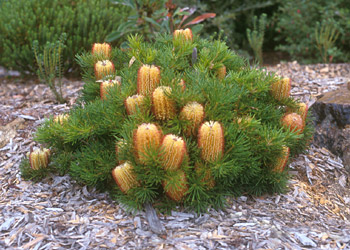 |
| Banksia spinulosa ‘Birthday Candles’ Photo: Brian Walters |
Banksias are tolerant of pruning and can be shaped to achieve a suitable form, for example near a path. You can choose to soften or emphasise any asymmetry or angularity. Two other attractive possibilities for small trees would be B.marginata (silver banksia) and B.aemula (wallum banksia), closely related to B.serrata but smaller. All those I have mentioned are from eastern Australia, but there are also other striking banksias from the west for the adventurous to try.
Most banksias grow as shrubs of all different sizes, often spherical or spreading rather than upright in form. During the winter months their flowers provide a constant, rich source of nectar and they attract honey-eating birds and, if you are lucky in where you live, small mammals such as pygmy possums. Their flower colours range from bright gold, orange and red to more subtle shades of lime, green, buff and brown.
A Banksia shrub on its own can be a striking specimen plant and potentially a focal point in the garden. Alternatively one species can be repeated, possibly with the delightful variation provided by, for example, the different forms of hairpin banksia (B.spinulosa). One or more species can be used in an informal hedge or screen, or grouped so their foliage creates a wonderful massed effect. The smaller leaves of B.spinulosa and B.ericifolia link in well with those of callistemons, melaleucas, some acacias and many other Australian natives. The more substantial leaves of other banksias contrast strongly with fine foliage, showing similarity to the foliage of waratahs and some dryandras, grevilleas and hakeas. Some banksias like moisture, though not bad drainage, particularly B.robur (swamp banksia) and B.aemula.
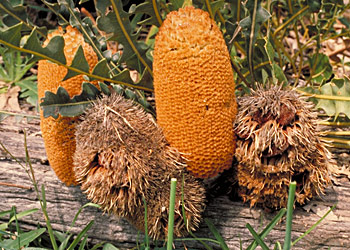 |
| A prostrate banksia, Banksia gardneri Photo: Brian Walters |
A number of prostrate banksias from Western Australia grow successfully in suitable conditions. B.blechnifolia, B.petiolaris and B.repens can all spread vigorously to provide ground cover on a grand scale. These plants are excellent on slopes and banks and, with upright flower spikes and cones and attractive foliage (beautifully coloured when new), their ornate texture is fascinating. A fourth species B.gardneri is less vigorous. In addition to these naturally occurring species, prostrate forms of other banksias such as B.spinulosa, B.ericifolia and B.serrata are now available from nurseries. These combine well with paving or rock shelves and other distinctive foliage such as tufted plants or the horizontal strata of Homoranthus species, and also extensive areas of softer groundcovers in similar tonings. As is true for the shrubs and trees, these prostrate banksias are conspicuous in the garden, not shy and retiring, so selecting their position requires a little thought. It is well worthwhile for their unique offering.
Cultivation of Dryandra
Margaret Pieroni and Keith Alcock
Margaret Pieroni is the current leader of ASGAP’s Dryandra Study Group and Keith Alcock is a former leader. This aticle was prepared by Margaret based on an earlier article written by Keith.
Note: This article was written in 1999, prior to the reclassification that merged Dryandra into the genus Banksia. The names of the plants mentioned in the article have not been updated to their current Banksia names. Current names can be found through the Australian Plant Census by using the search term “Dryandra”.
* * * * * *
Dryandra is a large group of 92 species and 34 infraspecific taxa belonging to the Proteaceae family. Their nearest relatives are the banksias. Both groups have flower heads or inflorescences made up of many hundreds or even thousands of individual flowers. The Banksia flowers are borne on elongated spikes, whereas the Dryandra flower heads are flattened and more like a waratah. Dryandras characteristically have a ring of bracts around the base of the flower heads. While in some species these are inconspicuous once the flowers have opened, a number of species have large showy bracts which surround the flower heads and show them off, much in the same way as the South African proteas. With some exceptions the flowers of dryandras are smaller than banksias, but what they lack in size they make up in numbers, for most species flower in profusion with flower heads sometimes growing at almost every leaf axil.
Flower colour is predominately yellow but every shade of yellow in the spectrum is represented, from greenish and lemon yellow through to rich, egg-yolk yellow and golden orange. Some have the yellow flowers suffused with pink, while there are about half a dozen species with red or wine coloured flowers. The remainder have brown shaded flowers, often two-toned, with colours ranging from chocolate and purplish brown through reddish brown and tan to light yellow brown and buff.
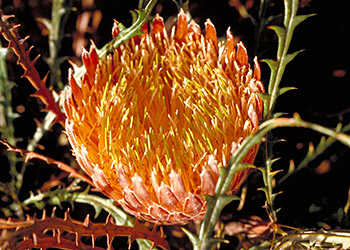 |
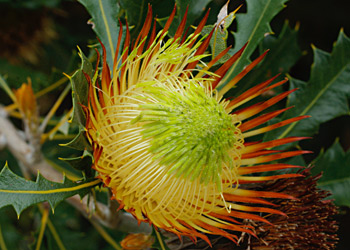 |
|
| Left: Dryandra proteoides Right: Dryandra quercifolia Photos: Margaret Pieroni, Brian Walters |
||
The bracts of dryandras are a very variable feature. In the 10-12 species with large showy bracts, such as D.proteoides, D.ferruginea and D.quercifolia, they are smooth and shiny and either golden brown or bronze in colour. They frame the yellow flowers to perfection. A few other species, such as D.speciosa, D.shutlleworthiana and D.plumosa have large furry bracts in brown tones, which complement the central flowers. In the remaining species the bracts are smaller, enveloping the flower buds but remaining inconspicuously at the base of the flower heads as they open.
Dryandras are small to medium shrubs which show a tremendous variation in form and foliage. They are probably the most attractive group of foliage plants in the Australian flora. There are about 25 prostrate or dwarf species, and about 20 tall shrubs that consistently reach over 2.5 metres in height. The rest range from 0.5 to 2 metres tall and may be upright or spreading in habit. Leaf form is a particularly attractive feature. Leaves are seldom entire, being frequently prickly toothed, pinnatifid or pinnate, or coarsely segmented. Leaf shape ranges from short linear and medium sized obovate to lanceolate. However, most are linear and usually very long and narrow, setting off the serrations to perfection.
Habitat
All dryandras are confined to the south-west of Western Australia and, while some are limited in occurrence, many are widespread though discontinuous in their distribution. They commonly occur in shallow, poor and clayey soils, most notably in lateritic gravelly situations. Where they occur in sandplain country they are usually indicators of shallow sand over lateritic gravel. While soils are shallow and poor they are invariably well drained.
Dryandras often occur in communities with more than one species present and are the dominant plants in such spots. Only a few species, including D.formosa, D.praemorsa, D.nobilis, D.squarrosa and sometimes D.polycephala and D.hewardiana occur in shade in forested situations. The remainder grow in full sun, though in communities rather than exposed positions.
Cultivation Requirements
The prime requirement for dryandras to grow well in cultivation is a freely drained topsoil While they come from shallow soils in the west and are more adaptable than banksias to shallow clay soils, they thrive on deep sandy soils and deep loams as well as shallow rocky soils – so long as all are well drained. Where soils are not naturally well drained, most dryandras will do well in beds raised 12-20 cm above ground level.
A sunny situation is necessary for most species. Most can tolerate dryness once established. Fertilisers are not usually necessary, though small applications of blood and bone or slow release fertilisers such as low phosphorus Osmocote are helpful at planting time. In alkaline soils some yellowing of leaves may be noted and may require foliar sprays of iron chelates to correct.
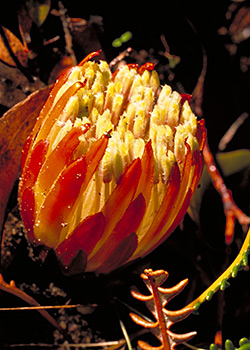 |
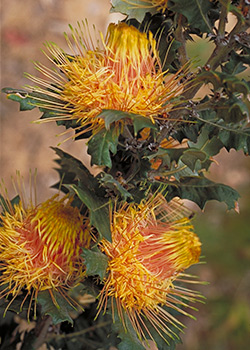 |
|
| Left: Dryandra obtusa Right: Dryandra praemorsa var. splendens Photos: Margaret Pieroni |
||
Hardy Dryandras for Beginners
The more dryandras are tried in cultivation the longer the list proven to be hardy. However, a number of species have long been in cultivation and are known to perform well under a variety of conditions. These include: D.praemorsa, D.fraseri, D.tenuifolia, D.cuneata, D.nivea, D.nervosa, D.quercifolia, D.drummondii, and D.obtusa.
Propagation
Dryandras can be grown from seed or cuttings. Seed is generally the most reliable, provided simple rules are followed. Most species will need to be extracted from the capsule prior to planting, the exception being the 8 or 9 species which shed seed between seasons or where a seed merchant has extracted seed already. Capsules can be ‘popped’ by heating in a fry pan at low heat (150-200oC) until they open or, more safely, the edges can be clipped off with nail clippers enabling the two halves to be prised open. Capsules contain one or two seeds either side of a separator.
Extracted seed is sown onto a sandy well drained mix, lightly covered with sand and kept in an open warm and sunny spot. Late February or April-May in Western Australia and South Australia and early September are the best times to sow. Prick out seedlings soon after they emerge (4-6 weeks) and pot on into an open friable mix with coarse sand the dominant component.
More variable results are obtained with cuttings, which have the added disadvantage that growth is often thick and unsuited to conventional treatment. Most success has been with semi-hard side shoot growth taken in late spring and mid-autumn.
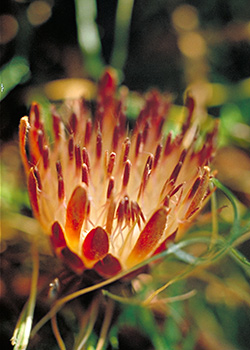
Photo: Margaret Pieroni
The Dryandra Study Group
The Dryandra Study Group of the Society for Growing Australian Plants has been in operation since 1974. The group has established a plantation at the Cranbourne (Victoria) annex of the Melbourne Botanic Gardens where well over 1000 plants are thriving. Most taxa are represented.
The Study Group shares field observations and experiences of members with propagation and cultivation through its newsletter.
Editor’s Note: Please note that Study Group members must also be members of one of the Regional Groups of the Australian Native Plants Society (Australia) – ANPSA.
Dryandras for Cultivation
(See footnote for key to letters in the ‘Cultivation’ and ‘Features’ columns)
|
Name
|
Size
H x W (m) |
Flower Colour
|
Cultivation
|
Features
|
|
|
acanthopoda
|
2 x 2
|
Yellow
|
H
|
F, C
|
|
|
anatona
|
4 x 1
|
Yellow
|
H
|
F, R
|
|
|
arborea
|
5-6 x 3-4
|
Yellow
|
D
|
F
|
|
|
arcototidis
|
0.3-0.5 x 1
|
Greenish yellow
|
H
|
L
|
|
|
armata var. armata
|
1-1.5 x 1.5
|
Bright yellow
|
H
|
F, C
|
|
|
armata var. ignicida
|
3 x 2
|
Yellow to pink
|
–
|
F
|
|
|
aurantia
|
Prostrate x 1-2
|
Orange
|
–
|
F, L, R
|
|
|
baxteri
|
1-2 x 1-2
|
Purplish brown
|
H
|
L
|
|
|
bipinnatifida subsp. bipinnatifda
|
Prostrate x 1
|
Yellow
|
H
|
F, L
|
|
|
bipinnatifida subsp. multifida
|
Prostrate x 1
|
Yellow
|
H
|
F, L
|
|
|
blechnifolia
|
Prostrate x 1
|
Brown and cream
|
H
|
L
|
|
|
borealis subsp. borealis
|
1 x 1
|
Yellow
|
H
|
F
|
|
|
borealis subsp. elatior
|
2.5 x 2
|
Yellow
|
H
|
F
|
|
|
brownii
|
0.75 x 0.75
|
Dark pink
|
H
|
F, L
|
|
|
calophylla
|
Prostrate x 2.5
|
Purple brown
|
H
|
L
|
|
|
carlinoides
|
1.5 x 2
|
Pink/cream
|
–
|
F, C
|
|
|
catoglypta
|
1 x 1
|
Golden/yellow
|
–
|
F, L, R
|
|
|
cirsiodes
|
1.5 x 1.5
|
Yellow
|
H
|
F, L
|
|
|
columnaris
|
2 x 0.5
|
Purple brown
|
–
|
L
|
|
|
comosa
|
2-3 x 3-4
|
Yellow
|
–
|
F, L
|
|
|
concinna
|
1-2.5 x 1.5
|
Yellow/green
|
–
|
L
|
|
|
conferta and varieties
|
1-2 x 1-2
|
Yellow
|
H
|
F, C
|
|
|
corvijuga
|
1 x 0.15
|
Yellow/rusty bracts
|
–
|
F, L
|
|
|
cuneata
|
1-2 x 2
|
Yellow
|
H
|
F, C
|
|
|
cynaroides
|
1 x 1.5
|
Orange/yellow
|
–
|
L
|
|
|
cypholoba
|
Prostrate x 1
|
Yellow
|
–
|
F, L
|
|
|
drummondii subsp. drummondii
|
0.5-1 x 1.5
|
Golden yellow/pink
|
H
|
L
|
|
|
drummondii subsp. hiemalis
|
1 x 1
|
Golden yellow
|
–
|
L
|
|
|
drummondii subsp. macrorufa
|
2 x 2
|
Red
|
–
|
L
|
|
|
echinata
|
2 x 2
|
Yellow
|
H
|
F, C
|
|
|
epimicta
|
Prostrate x 1
|
Yellow/brown bracts
|
H
|
L, R
|
|
|
erythrocephala var. erythrocephala
|
1-2 x 1.5
|
Maroon/cream
|
H
|
L
|
|
|
erythrocephala var. inopinata
|
1-2 x 1.5
|
Golden yellow
|
H
|
L
|
|
|
falcata
|
1-3 x 2
|
Yellow
|
H
|
F
|
|
|
fasiculata
|
1.5 x 0.5
|
Yellow
|
–
|
L
|
|
|
ferruginea subsp. ferruginea
|
0.4-2 x 0.5-1
|
Yellow/rust red bracts
|
D
|
F, L
|
|
|
ferruginea subsp. tutanningensis
|
1 x 1
|
Yellow/rust red bracts
|
H
|
F, L, R
|
|
|
ferruginea subsp. pumila
|
0. 5 x 0.5
|
Yellow/rust red bracts
|
H
|
F, L, R
|
|
|
ferruginea subsp. obliquiloba
|
1 x I
|
Yellow/rust red bracts
|
–
|
F, L
|
|
|
ferruginea subsp. chelomacarpa
|
Prost. x 1. 5
|
Yellow/rust red bracts
|
–
|
F, L
|
|
|
ferruginea subsp. flavescens
|
Prost. x 1.5
|
Yellow/rust red bracts
|
–
|
F, L
|
|
|
fililoba
|
1 x 1
|
Brown and cream
|
H
|
L
|
|
|
foliolata
|
1-2 x 1-2.5
|
Cream/dull red
|
H
|
L
|
|
|
foliosissima
|
1.5-2.5 x 2
|
Pale yellow
|
H
|
L
|
|
|
formosa
|
2-5 x 2-4
|
Orange
|
H
|
F, C
|
|
|
fraseri var. fraseri
|
0.5 x 1-2
|
Yellow sometimes pink
|
H
|
F
|
|
|
fraseri var, ashbyi
|
0.5 x 1
|
Yellow sometimes pink
|
–
|
F
|
|
|
fraseri var, oxycedra
|
2.5 x 2
|
Yellow sometimes pink
|
H
|
F, L, C
|
|
|
fuscobractea
|
1 x 0.5
|
Pale yellow
|
–
|
F
|
|
|
glauca
|
1.5 x 1.5
|
Yellow
|
–
|
F
|
|
|
hewardiana
|
2-4 x 2-4
|
Bright yellow
|
H
|
F, C
|
|
|
hirsuta
|
2 x 1. 5
|
Yellow with pink
|
H
|
F, C
|
|
|
hornda
|
0.5-1.5 x 1.5
|
Yellow/orange bracts
|
–
|
L
|
|
|
idiogenes
|
0.75 x 0.75
|
Red and white
|
H
|
F, L
|
|
|
ionthocarpa
|
0.6 x 0.6
|
Purple-pink and yellow
|
H
|
F, L, R
|
|
|
kippistiana var. kippistiana
|
1-1.5 x 1.5
|
Pale yellow
|
–
|
F, L, C
|
|
|
kippistiana var, paenepeccata
|
0.75 x 0.5
|
Pale yellow
|
–
|
F, C
|
|
|
lepidorhiza
|
Prostrate x 1.5
|
Dull pink
|
H
|
L, R
|
|
|
lindleyana subsp. Iindleyana var. lindleyana
|
Prostrate x 2
|
Yellow, buff or red
|
H
|
L
|
|
|
lindleyana subsp, lindleyana var. mellicula
|
0.5 x 2
|
Yellow, buff or red
|
H
|
L
|
|
|
lindleyana subsp. pollosta
|
Prostrate x 1
|
Yellow, buff or red
|
–
|
L
|
|
|
lindleyana subsp. media
|
Prostrate x 1
|
Yellow
|
–
|
L
|
|
|
lindleyana subsp. agricola
|
Prostrate x 0.5
|
Yellow
|
–
|
L
|
|
|
lindleyana subsp. sylvestris
|
Prostrate x 0.5
|
Yellow, buff or red
|
–
|
L
|
|
|
longifolia subsp. Iongifolia
|
2 x 2-3
|
Yellow
|
H
|
F, L, C
|
|
|
longifolia subsp. calcicola
|
1.5 x 1.5
|
Yellow
|
H
|
F, L, C
|
|
|
longifolia subsp. archeos
|
1.5 x 1
|
Yellow
|
–
|
F, L, C
|
|
|
meganotia
|
1 x 0.5
|
Golden yellow
|
–
|
F, L
|
|
|
mimica
|
Prostrate x 1
|
Golden yellow
|
H
|
L, R
|
|
|
montana
|
2 x 1.5
|
Yellow/bracts rusty red
|
–
|
L, R
|
|
|
mucronulata subsp. mucronulata
|
1-2 x 2-3
|
Golden amber
|
H
|
L
|
|
|
mucronulata subsp. retrorsa
|
2 x 1.5
|
Yellow/pink
|
H
|
F, L, C
|
|
|
nana
|
0.4 x 0.5-1.5
|
Yellow
|
–
|
L
|
|
|
nervosa
|
1 x 1
|
Brown cream
|
H
|
L
|
|
|
nivea subsp. nivea
|
1 x 1
|
Yellow, buff, red
|
H
|
L
|
|
|
nivea subsp. uliginosa
|
1.5 x 1.5
|
Yellow, buff, red
|
–
|
L
|
|
|
nivea ‘Morangup’
|
1 x 1
|
Dark pink and white
|
–
|
L
|
|
|
nobilis subsp. nobilis
|
2-4 x 3-4
|
Orange
|
H
|
F,C
|
|
|
nobilis subsp. fragrans
|
2-3 x 1-2
|
Orange
|
H
|
F, L
|
|
|
obtusa
|
0.3 x 1-2
|
Yellow/red brown bracts
|
H
|
F, L
|
|
|
octotriginta
|
1 x 1
|
Golden yellow
|
H
|
F, L
|
|
|
pallida
|
2 x 1
|
Pale yellow
|
–
|
L
|
|
|
platycarpa
|
1 x 0.5
|
Yellow or brown
|
–
|
F
|
|
|
plumosa subsp. plumosa
|
1.5 x 2-3
|
Yellow
|
H
|
L
|
|
|
plumosa subsp. denticulata
|
1.5 x 2-3
|
Yellow
|
H
|
L
|
|
|
polycephala
|
2-3 x 1-2
|
Bright yellow
|
H
|
F, C
|
|
|
porrecta
|
Prostrate x 2-3
|
Pink and yellow
|
H
|
L
|
|
|
praemorsa var. praemorsa
|
2-3 x 1.5
|
Yellow
|
H
|
F, C
|
|
|
praemorsa var. splendens
|
2-3 x 1.5-3
|
Yellow sometimes pink
|
H
|
F, C
|
|
|
preissii
|
0.3 x 1.5
|
Orange yellow
|
H
|
F, L
|
|
|
pseudoplumosa
|
2 x 1
|
Yellow/rust
|
–
|
F, L
|
|
|
pteridifolia subsp. pteridifolia
|
Prostrate x 1-2
|
Yellow/pink
|
–
|
L, F
|
|
|
ptendifolia subsp. vernalis
|
Prostrate x 1-2
|
Cream
|
–
|
L
|
|
|
proteoides
|
1-2 x 1-2
|
Yellow brown/pinkish brown bracts
|
D
|
F, L
|
|
|
pulchella
|
1-2 x 1-2
|
Yellow
|
–
|
L, F
|
|
|
purdieana
|
1-2 x 1
|
Yellow
|
–
|
F
|
|
|
quercifolia
|
1-2 x 2
|
Yellow sometimes pink
|
H
|
F, C
|
|
|
rufstylis
|
1.5 x 0.5
|
Yellow and red
|
–
|
L
|
|
|
sclerophylla
|
1 x 1.5
|
Yellow
|
–
|
L
|
|
|
seneciifolia
|
1-2 x 1.5
|
Purplish red/yellow
|
H
|
L
|
|
|
serra
|
2-4 x 2-3
|
Pale yellow
|
H
|
F
|
|
|
serratuloides subsp. serratuloides
|
0.5-1 x 1-1.5
|
Pink/green
|
–
|
F, L
|
|
|
serratuoides subsp. perissa
|
0.5-1 x 1-1.5
|
Pink/brown bracts
|
D
|
F, L
|
|
|
sessilis and varieties
|
2-6 x 2-4
|
Greenish yellow
|
H
|
F
|
|
|
shanklandiorum
|
1.5 x 1.5
|
Yellow/pink
|
H
|
F, L
|
|
|
shuttleworthiana
|
1 x 0.5-1
|
Red brown/orange bracts
|
–
|
F, L
|
|
|
speciosa subsp. speciosa
|
1.5 x 1.5
|
Pale orange/grey bracts
|
H
|
F
|
|
|
speciosa subsp. macrocarpa
|
0.5 x 1.5
|
Red/grey bracts
|
H
|
F
|
|
|
squarrosa
|
1.5-2.5 x 0.8-1.2
|
Yellow
|
–
|
F
|
|
|
stenoprion
|
Prostrate x 1
|
Yellow
|
H
|
L
|
|
|
stricta
|
3 x 2
|
Yellow
|
H
|
F, L C
|
|
|
stuposa
|
1.5-2.5 x 2
|
Orange yellow
|
H
|
F, C
|
|
|
subpinnatifda var. subpinnatifda
|
1-2 x 1-2
|
Yellow/green
|
H
|
F, L
|
|
|
subpinnatifda var. imberbis
|
0.5-1 x 0.5-1
|
Yellow
|
–
|
L
|
|
|
subulata
|
0.3 x 0.5-1
|
White/brown
|
–
|
L
|
|
|
tenuifolia var. tenuifolia
|
0.5-2 x 1-2
|
Purple brown/red bracts
|
H
|
F, L
|
|
|
tenuifolia var. reptans
|
Prostrate
|
Purple brown/red bracts
|
H
|
F
|
|
|
tortifolia
|
0.3-0.5 x 0.5
|
Yellow-red
|
H
|
L
|
|
|
tridentata
|
0.3-0.5 x 1
|
Yellow
|
D
|
F, L
|
|
|
trifontinalis
|
3 x 2
|
Yellow
|
H
|
F, L
|
|
|
vestita
|
0.5-1 x 2
|
Golden yellow
|
–
|
L
|
|
|
viscida
|
1 x 1
|
Golden yellow
|
H
|
F, L
|
|
|
wonganesis
|
3 x 2
|
Yellow
|
–
|
F, L
|
|
|
xylothemelia
|
1 x 1
|
Yellow
|
–
|
F
|
|
| Key: Cultivation Column: H = Hardy; D = Difficult; – = Insufficient Information Features Column: F = Especially attractive flowers; L = Especially good foliage plant; C = Good for cut flowers; R = Rare in the wild |
|||||
The Dryandra Study Group has developed a gallery containing images of the known members of the former genus Dryandra. The corresponding new Banksia names as published by Mast and Thiele are also listed.
Banksia & Dryandra Study Groups
These two study groups are part of a number of Study Groups within ANPSA. Their aim is to further knowledge about the cultivation, propagation and conservation of members of the genera Banksia and Dryandra.
Although ANPSA accepts the reclassification of Dryandra into an expanded Banksia genus, this is not accepted by the two study groups at present.
Further information about the Study Groups, their activities and access to the newsletter archives can be found at the links below.
Banksia – Further Information
Most books dealing with Australian native plants will contain useful information on the botany and horticulture of banksias and dryandras (members of the former genus Dryandra). There are also a number of Banksia resources on the internet. Some of the most detailed references are listed below – most of these will still refer to Dryandra as a separate genus.
Books:
- Cavanagh A and Pieroni M (2006), The Dryandras, Australian Plants Society (SGAP Victoria) Inc and Wildflower Society of Western Australia Inc. in association with Bloomings Books, Melbourne.
- Collins, K, Collins, C and George, A (2008), Banksias, Bloomings Books.
- Elliot, W. R and Jones D (1982), The Encyclopaedia of Australian Plants, Vol.2, Lothian Publishing Company Pty Ltd, Melbourne.
- Elliot, W. R and Jones D (1984), The Encyclopaedia of Australian Plants, Vol.3, Lothian Publishing Company Pty Ltd, Melbourne.
- George, A (1981) The Genus Banksia in “Nuytsia” Vol.3 No.3, The Western Australian Herbarium, Department of Agriculture, Western Australia.
- George, A.S (1984). An Introduction to the Proteaceae of Western Australia, Kangaroo Press, Kenthurst.
- George, A (1996), The Banksia Book, 3rd Edition, Kangaroo Press in association with the Society for Growing Australian Plants.
- George, A.S (1996). New taxa and a new infrageneric classification in Dryandra R.Br.(Proteaceae: Grevilleoideae). Nuytsia 10(3): 313 – 408.
- George, A.S (2011). A Banksia Album: 200 years of botanical illustration. National Library of Australia, Canberra.
- Griffin E.A (1985). Studies in the genus Dryandra R.Br. (Proteaceae) 1. Species distribution, ecology and conservation status, Western Australian Herbarium Research Notes, No.11: 1 – 40.
- Holliday, I and Watton, G (1990), A Field Guide to Banksias, Hamlyn Publishers, Port Melbourne.
- Sainsbury, R (1984). Field guide to Dryandra, University of Western Australia Press, Nedlands.
- Taylor, A and Hopper, S (1988), The Banksia Atlas, Australian Flora and Fauna Series, No.8, Australian Government Publishing Service.
- Wallace, I (2010), An Illustrated Guide to Eastern Banksias, published by the author.
- Wrigley, J and Fagg, M (1989), Banksias, Waratahs and Grevilleas, Collins Publishers Australia.
Journals:
Several issues of the Society’s journal “Australian Plants” are particularly useful for those interested in Banksia.
- Vol 9, No.71 Jume 1977; Banksia propagation and culture; Growing western Banksia in Canberra.
- Vol 13, No.105 December 1985; Banksia integrifolia and its relatives.
- Vol 14, No.114 March 1988; Description of eastern Banksia species with many photos.
- Vol 15, No.124 September 1990; Description of western Banksia species with many photos; The Banksia flower.
- Vol 18, No.141 December 1994; “Landscaping with Dryandra” and “A Growing Guide for Beginners”.
- Vol 20, No.158 March 1999; Banksia coccinea cultivars; Banksia – detailed review of botany, cultivation and propagation.
- Vol 20, No.160 September 1999; Banksia plagiocarpa; some notes on northern Queensland banksias
- Vol 20, No.160 September 1999; “The ‘Honeypot’ Dryandras”; Dryandra seed germination.
- Vol.21 No.166 March 2001; Detailed report on Banksia propagation and cultivation; In-vitro propagation.
- Vol.21 No.173 December 2002; Banksia in Horticulture; Banksia tricuspis; numerous photos.
Internet:
- Banksia Study Group newsletters – recent issues are available here.
- A Feast of Banksias
- Banksia – Australian National Botanic Gardens.
- Banksia as Bonsai.
- Could this be Australia’s rarest Banksia? Banksia vincentia (Proteaceae), a new species known from fourteen plants from south-eastern New South Wales, Australia (pdf)
- Cultivation of Dryandra
- Dryandra cladistic classification to Banksia – naming dispute. A personal view from Kevin Collins of The Banksia Farm, Mt Barker, Western Australia.
- Growing Native Plants – a series of plant profiles by the Australian National Botanic Gardens; includes a number of banksias.
- Growing Banksias in Northern Victoria
- Growing Western Banksias in Containers
- Holly-leaved Banksia – Banksia ilicifolia
- The Dryandras – About the Book
- The Propagation of Banksia
- Starlight’s Banksia – Banksia paludosa subsp. astrolux
- So Dryandra Becomes Banksia – What’s All the Fuss About? A comment on the taxonomy behind the proposed reclassification of Dryandra into Banksia.
- Wallum Banksia – Banksia serratifolia
- You Don’t Have to call Dryandra Banksia. Just because new taxonomy has been published, doesn’t mean you have to accept it.
 Australian Native Plants Society (Australia)
Australian Native Plants Society (Australia)